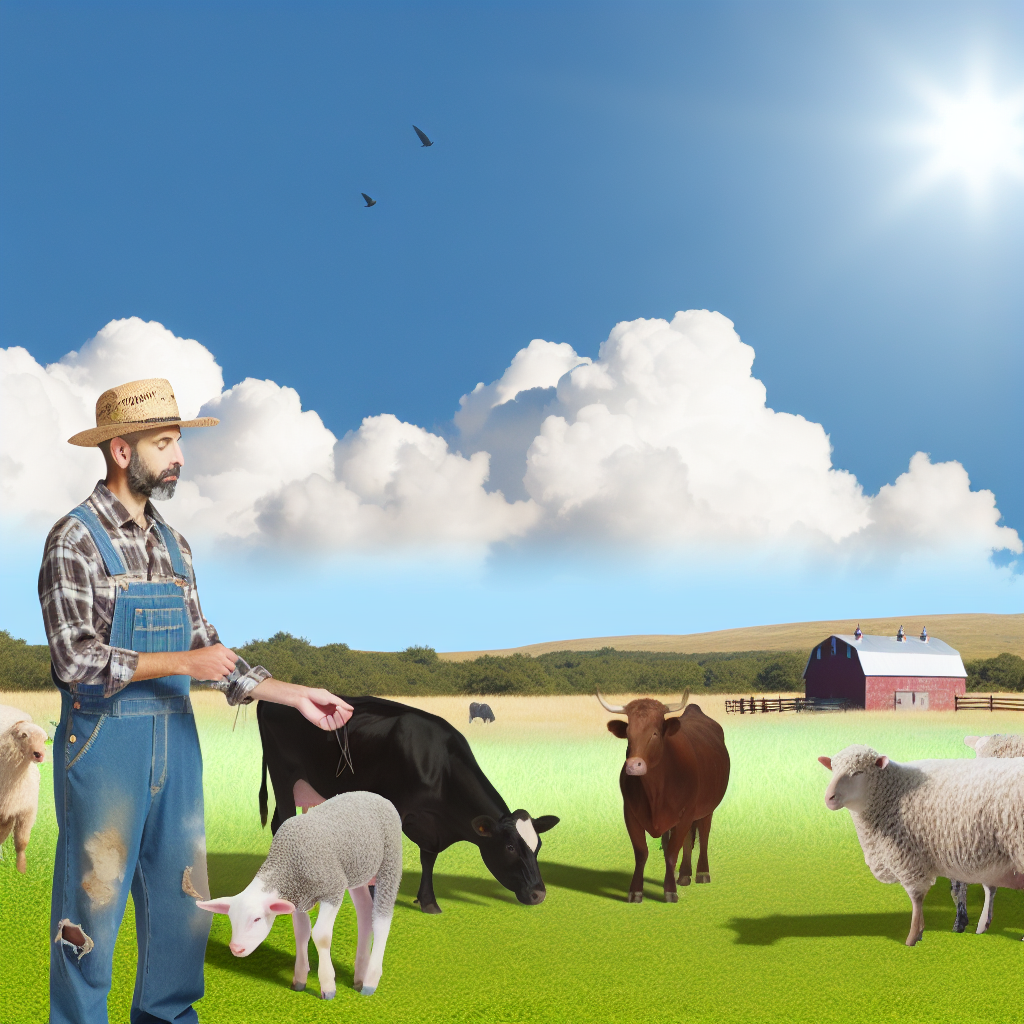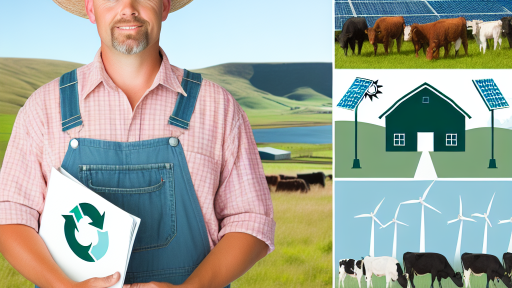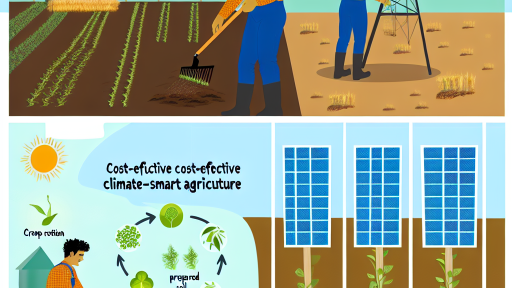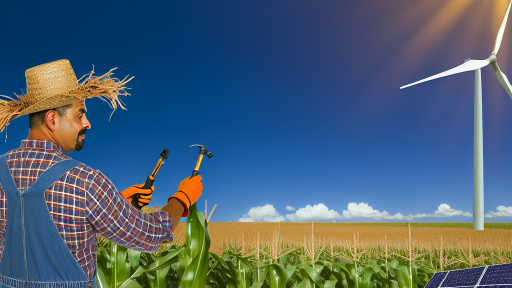Introduction to Climate-Smart Livestock Management
Definitions and Importance
Climate-smart livestock management refers to practices designed to support sustainable farming.
This approach aims to increase productivity while reducing greenhouse gas emissions.
Farmers benefit from adopting these techniques as they enhance resilience to climate change.
Moreover, this management style improves the livelihoods of rural communities.
It ensures food security in a changing climate.
Key Principles of Climate-Smart Practices
The principles of climate-smart livestock management include three main goals.
First, enhance productivity from livestock systems.
Second, reduce greenhouse gas emissions from animal husbandry.
Third, support farmers’ adaptation to climate impacts.
Benefits for Farmers
Implementing climate-smart practices yields several benefits for farmers.
- Increased farm profitability through efficient resource use.
- Improved animal health and productivity.
- Enhanced market access due to sustainable practices.
Additionally, these practices promote environmental health.
Consequently, farmers can contribute to global sustainability efforts.
Examples of Climate-Smart Techniques
Farmers can implement various techniques to achieve climate-smart livestock management.
- Utilizing improved breeds that offer higher productivity.
- Adapting feed strategies to enhance nutrient efficiency.
- Incorporating rotational grazing to improve pasture health.
These techniques mitigate climate risks while boosting farm outputs.
Overall, such innovations pave the way for a more sustainable future in agriculture.
Transform Your Agribusiness
Unlock your farm's potential with expert advice tailored to your needs. Get actionable steps that drive real results.
Get StartedImpact of Climate Change on Livestock Farming
Current Trends in Livestock Farming
Climate change significantly affects livestock farming today.
Rising temperatures strain animal health and productivity.
Additionally, erratic weather patterns disrupt feed availability.
Farmers notice increased diseases among their herds.
Moreover, livestock emissions contribute to greenhouse gases.
Challenges Faced by Farmers
Farmers encounter several challenges due to climate impacts.
Water scarcity threatens the survival of livestock.
Heat stress decreases milk production in dairy cows.
Furthermore, heat waves lead to higher mortality rates.
Many farmers struggle to adapt to these changing conditions.
Future Projections for Livestock Farming
Experts predict changes in livestock farming practices.
Farmers may adopt climate-smart strategies in the coming years.
This includes improved breeding for heat resistance.
Additionally, optimizing diets can enhance digestion and reduce emissions.
The use of technology will likely play a significant role.
Turning to Sustainable Practices
Sustainable practices can mitigate some of climate change’s effects.
Rotational grazing improves pasture health and carbon sequestration.
Integrated crop-livestock systems increase overall farm resilience.
Farmers may also diversify their livestock breeds.
Furthermore, investing in renewable energy sources can reduce operational costs.
Key Principles of Climate-Smart Agriculture: Focus on Livestock Systems
Enhancing Livestock Resilience
Farmers should develop strategies to enhance livestock resilience against climate change.
This includes selecting breeds better suited for local climate conditions.
For instance, heat-tolerant cattle can thrive in warmer temperatures.
Additionally, providing shade and ventilation improves animal welfare.
Showcase Your Farming Business
Publish your professional farming services profile on our blog for a one-time fee of $200 and reach a dedicated audience of farmers and agribusiness owners.
Publish Your ProfileFarmers can also integrate silvopasture, combining trees and pasture for shade.
Optimizing Feed Resources
Efficiently managing feed resources is crucial for climate-smart livestock management.
Farmers should prioritize high-quality forage to support animal health.
Incorporating legumes into pastures can enhance nitrogen levels naturally.
This practice reduces the need for synthetic fertilizers, lowering costs.
Additionally, supplemental feeding during dry seasons can maintain productivity.
Water Resource Management
Proper water management is essential for sustainable livestock systems.
Farmers must evaluate their water sources and usage regularly.
Implementing rainwater harvesting systems can supplement water supply.
Furthermore, using water-efficient technologies minimizes waste.
Routine monitoring and maintenance of water systems enhance availability.
Reducing Greenhouse Gas Emissions
To mitigate climate impact, farmers must focus on reducing greenhouse gas emissions.
Practices such as rotational grazing help improve soil carbon storage.
Moreover, integrating legumes into animal diets can decrease methane emissions.
Utilizing manure management practices can also capture methane for energy use.
Farmers should invest in training to adopt these innovative practices effectively.
Integrating Agroecological Practices
Integrating agroecological principles fosters sustainable livestock systems.
Farmers are encouraged to diversify livestock breeds for resilience.
This approach helps in managing pests and diseases more effectively.
Promoting native plant species can improve biodiversity alongside livestock systems.
Moreover, employing cover crops enhances soil health and fertility.
Knowledge Sharing and Community Engagement
Knowledge sharing within farming communities strengthens climate-smart practices.
Farmers should join local groups to exchange insights and experiences.
Collaborations with research institutions can also provide valuable information.
Participating in workshops helps farmers stay informed about climate-smart techniques.
Community engagement drives collective action towards sustainability.
Delve into the Subject: Rainwater Harvesting Tips for Enhanced Farm Water Use
Sustainable Feed Practices: Enhancing Livestock Diets for Reduced Environmental Impact
Importance of Sustainable Feeding
Sustainable feeding practices play a crucial role in livestock management.
They minimize environmental harm while maximizing productivity.
Moreover, they contribute to the health of livestock and ecosystems.
Choosing Nutritious Feed Ingredients
Selecting high-quality feed ingredients is essential for livestock health.
Nutrient-rich feeds can enhance growth and produce better yields.
Look for ingredients that are sustainably sourced and less resource-intensive.
Utilizing By-products
Farmers can incorporate by-products into livestock diets.
By-products often provide excellent nutrition at lower costs.
For instance, using spent grains from breweries can be beneficial.
Incorporating Forage
Integrating forage into diets promotes natural grazing behavior.
Forage can also improve soil health through root systems.
Additionally, it reduces the reliance on grain, lowering feed costs.
Incorporating Supplements Wisely
Supplements can enhance livestock diets for specific needs.
Showcase Your Farming Business
Publish your professional farming services profile on our blog for a one-time fee of $200 and reach a dedicated audience of farmers and agribusiness owners.
Publish Your ProfileConsider probiotics, minerals, and vitamins to optimize health.
Always consult with a livestock nutritionist before introducing new supplements.
Monitoring and Adjusting Diets
Regularly assessing livestock diets ensures nutritional needs are met.
Adjustments may be necessary based on growth stages or production goals.
Use feed testing services to analyze nutrient content effectively.
Reducing Feed Waste
Minimizing feed waste is essential for sustainability.
Implement practices that help manage feed more efficiently.
Consider adjusting feed quantities based on consumption patterns.
Implementing Feeding Strategies
Implementing strategic feeding schedules can reduce waste.
For example, feed smaller, more frequent portions throughout the day.
This approach helps keep livestock content and reduces leftovers.
Educating Employees
Training farm staff on proper feeding practices is vital.
Educated employees can better monitor feed use and manage waste.
Additionally, they can identify potential issues before they escalate.
Long-term Benefits of Sustainable Feeding
Adopting sustainable feed practices promotes environmental stewardship.
These methods improve livestock health while supporting farm profitability.
Ultimately, they contribute to a more resilient agricultural system.
You Might Also Like: How to Adapt Crops for a Changing Climate
Water Management Techniques for Climate Resilience in Livestock Farming
Importance of Water Conservation
Water is a critical resource in livestock farming.
Efficient water management enhances farm sustainability.
In fact, it reduces costs and increases productivity.
Moreover, conserving water helps mitigate climate change impacts.
Rainwater Harvesting Strategies
Rainwater harvesting captures precipitation for future use.
Farmers can install systems to collect rainwater effectively.
This technique reduces dependency on traditional water sources.
Additionally, it provides a reliable water supply during dry periods.
Choosing the Right Equipment
Select appropriate gutters and storage tanks for efficiency.
Optimize the design for maximum water collection.
Regular maintenance ensures the longevity of the system.
Implementing Simple Systems
Even small farms can benefit from rainwater harvesting.
Using barrels beneath downspouts is a practical solution.
These systems can be built without extensive investment.
Improving Irrigation Practices
Advanced irrigation techniques save water and improve yields.
Drip irrigation delivers water directly to plant roots.
This method minimizes evaporation and runoff loss.
Furthermore, it enables precise water application based on plant needs.
Implementing Scheduling Techniques
Schedule irrigation based on weather forecasts.
This practice avoids unnecessary water use during rain events.
Utilizing moisture sensors helps determine optimal watering times.
Water Recycling Options
Recycling water can significantly reduce consumption.
Showcase Your Farming Business
Publish your professional farming services profile on our blog for a one-time fee of $200 and reach a dedicated audience of farmers and agribusiness owners.
Publish Your ProfileFarmers can treat and reuse water from washing equipment.
This practice not only saves water but also improves efficiency.
Setting Up Treatment Systems
Consider investing in simple treatment systems.
Biofilters and settling tanks can effectively clean water.
Using treated water for irrigation supports sustainability goals.
Educating Staff on Water Use
Training staff in water conservation practices is essential.
Awareness leads to better water management on the farm.
Encourage innovation and new ideas for water efficiency.
Monitoring Water Usage
Regularly tracking water usage helps farmers identify inefficiencies.
Use meters to gather data on water consumption patterns.
This information is crucial for making informed decisions.
Reviewing Water Management Strategies
Regular assessments of water management plans improve results.
Adjust systems based on changing climate conditions.
Seek feedback from farm staff to refine techniques over time.
Delve into the Subject: Boost Farm Sustainability with Carbon Sequestration
Integrating Agroforestry with Livestock: Benefits and Best Practices
Understanding Agroforestry
Agroforestry combines agriculture and forestry practices.
This integration can enhance farm productivity and biodiversity.
Farmers plant trees alongside crops and livestock to create a sustainable ecosystem.
Consequently, this method provides various benefits to farmers and the environment.
Benefits of Agroforestry in Livestock Management
Agroforestry promotes better soil health through improved nutrient cycling.
Trees help prevent soil erosion by stabilizing the ground with their roots.
This method also provides shade for livestock, reducing heat stress.
Moreover, trees can offer forage for animals, boosting their nutrition.
Enhancing biodiversity through agroforestry helps control pests naturally.
Best Practices for Implementing Agroforestry
Farmers should start by selecting appropriate tree species for their region.
Choosing native trees can improve resilience to local pests and diseases.
Incorporating trees at various densities can optimize land use.
Farmers must ensure proper spacing for both trees and livestock.
This spacing allows for adequate sunlight and airflow, benefiting all plants.
Planning and Management Considerations
Effective planning is crucial for the success of agroforestry systems.
Farmers should assess their land’s soil type and topography before planting.
Regular monitoring and maintenance of trees are necessary for healthy growth.
Integrated pest management strategies can further enhance crop and livestock health.
Additionally, fostering community involvement can spread knowledge of best practices.
Case Studies and Success Stories
The Smith family in Nebraska increased their farm’s productivity by integrating agroforestry.
They planted oak trees, providing shade and forage to their cattle.
The results included healthier livestock and improved soil conditions.
In Brazil, smallholder farmers have successfully combined coconut palms with pasture.
This system boosted milk production while enhancing land resilience.
Moving Forward with Agroforestry
Farmers can benefit from training programs focused on agroforestry techniques.
Showcase Your Farming Business
Publish your professional farming services profile on our blog for a one-time fee of $200 and reach a dedicated audience of farmers and agribusiness owners.
Publish Your ProfileAdditionally, local agricultural extension services can provide valuable support.
Engaging in research and development helps improve agroforestry practices.
Ultimately, integrating agroforestry with livestock management promotes sustainability.
This approach can enhance food security while preserving the environment.
Discover More: Drought-Resistant Crops for Sustainable Farming

Technological Innovations for Climate-Smart Livestock Management
Overview of Technological Advancements
Technological advancements play a crucial role in livestock management.
These innovations enhance productivity while reducing climate impact.
Farmers can leverage new tools for better livestock health and efficiency.
Precision Livestock Farming
Precision livestock farming utilizes data to optimize animal care.
This technology uses sensors to monitor animal health and behavior.
Farmers receive real-time data, enabling timely interventions.
Moreover, these technologies improve feed efficiency and reduce waste.
Genomic Selection
Genomic selection is revolutionizing breeding programs in livestock.
This technique uses genetic information to select desirable traits.
As a result, farmers can breed animals that are more resilient to climate stressors.
This method also enhances productivity and reduces environmental footprints.
Smart Feeding Systems
Smart feeding systems optimize nutrition for livestock.
Automated feeders adjust rations based on real-time data.
These systems help reduce feed waste and improve growth rates.
Additionally, they contribute to lowering greenhouse gas emissions.
Remote Monitoring Technologies
Remote monitoring technologies provide insights into livestock health.
Farmers can use GPS and RFID technologies for tracking movements.
These tools help in managing grazing patterns effectively.
Consequently, farmers can make informed decisions on resource use.
Integration of Drones and Aerial Imagery
Drones are transforming livestock management practices.
They provide aerial views of pastures, helping with land management.
Farmers can assess animal distributions and pasture conditions efficiently.
This technology additionally aids in monitoring environmental changes.
Applications of IoT in Livestock Management
The Internet of Things (IoT) is enhancing livestock operations.
Connected devices help monitor animal health and environmental conditions.
IoT systems enable farmers to track feed and water usage effectively.
Ultimately, this leads to improved sustainability in livestock management.
Technological Integration in Livestock Management
The integration of technology in livestock management proves vital.
These innovations not only enhance efficiency but also support sustainability.
As farmers adopt these tools, they can better adapt to climate challenges.
This approach paves the way for a more resilient agricultural future.
Policy Frameworks and Support for Farmers Adopting Climate-Smart Practices
Understanding Policy Frameworks
Policy frameworks shape the agricultural landscape significantly.
These frameworks include government regulations and incentives.
They provide structure for implementing sustainable practices.
Moreover, frameworks offer guidelines that farmers can follow.
Showcase Your Farming Business
Publish your professional farming services profile on our blog for a one-time fee of $200 and reach a dedicated audience of farmers and agribusiness owners.
Publish Your ProfileThese guidelines ensure that farming practices align with climate goals.
Government Programs and Incentives
Government programs play a vital role in supporting farmers.
For instance, subsidies can lower the cost of sustainable practices.
Tax incentives motivate farmers to invest in eco-friendly technologies.
Funding opportunities enable farmers to adopt innovative solutions.
Additionally, training programs enhance skills in climate-smart farming.
Public-Private Partnerships
Public-private partnerships can foster collaboration in agriculture.
These partnerships unite government entities and private organizations.
They work together to develop effective climate-smart solutions.
Such collaborations can improve access to resources for farmers.
Ultimately, they encourage the sharing of knowledge and best practices.
Community Engagement and Support Systems
Community support systems are essential for successful implementation.
They facilitate peer learning among farmers.
These systems promote the exchange of experiences and strategies.
Furthermore, local organizations often offer resources and assistance.
This creates a supportive environment for sustainable practices.
Monitoring and Evaluation Mechanisms
Monitoring and evaluation are crucial for assessing progress.
These mechanisms help identify effective strategies that work.
Farmers benefit from understanding the impact of their practices.
Moreover, evaluation results guide future policy adjustments.
These adjustments ensure continued support for farmers.
Case Studies: Successful Implementation of Climate-Smart Livestock Management Worldwide
Improving Grazing Practices in Kenya
In Kenya, farmers improved grazing practices to adapt to changing climates.
They adopted rotational grazing systems successfully.
This method enhanced pasture quality and increased livestock resilience.
As a result, farmers reported higher milk production from their herds.
Utilizing Integrated Crop-Livestock Systems in Brazil
Farmers in Brazil implemented integrated crop-livestock systems.
This practice optimized land use and reduced greenhouse gas emissions.
By alternating crops with livestock grazing, they improved soil health.
This strategy enhanced food security and farming profitability.
Innovative Feeding Solutions in Australia
In Australia, ranchers explored innovative feeding solutions.
They began incorporating forages that are drought-resistant.
This shift decreased feed costs and minimized environmental impacts.
Farmers observed improved animal health and reduced mortality rates.
Community-Based Programs in India
In India, community-based programs facilitated climate-smart practices.
Farmers received training on sustainable livestock management techniques.
This approach strengthened local resilience to climate challenges.
It also fostered collaboration among farmers for shared resources.
Technology Integration in the United States
In the United States, advanced technologies improved livestock management.
Farmers utilized data analytics to monitor animal health and grazing patterns.
This integration significantly boosted productivity and efficiency.
Showcase Your Farming Business
Publish your professional farming services profile on our blog for a one-time fee of $200 and reach a dedicated audience of farmers and agribusiness owners.
Publish Your ProfileAdditionally, it allowed for more informed decision-making.
The Future of Livestock Farming in a Changing Climate
Embracing Climate-Smart Practices
Farmers must adopt climate-smart practices to thrive in a changing environment.
These practices enhance productivity while minimizing environmental impacts.
Technologies such as rotational grazing can significantly improve soil health.
Moreover, these methods help sequester carbon, contributing to climate goals.
Farmers can also incorporate resilient livestock breeds for better adaptability.
Building Sustainable Livestock Systems
Sustainable livestock systems focus on resource efficiency.
Circular economy approaches reduce waste and promote recycling of nutrients.
Farmers can implement integrated systems with crop and livestock synergy.
This diversity creates resilience against climate shocks and fluctuations.
Additionally, utilizing agroforestry can enhance farm biodiversity.
Engaging with Local Communities
Communities must collaborate to develop effective livestock management strategies.
Sharing insights among farmers fosters innovation and learning.
Establishing local networks can facilitate better access to resources.
Community-driven solutions often lead to tailored adaptations.
This immersive approach increases the overall resilience of local agriculture.
Policy Support and Research Development
Effective policies can provide essential support for livestock farmers.
Government initiatives should promote research in climate-smart technologies.
Subsidies for sustainable practices can incentivize farmers to shift their methods.
Furthermore, access to financial resources assists farmers in making necessary upgrades.
Collaboration with research institutions can lead to innovative solutions.
Looking Ahead: Opportunities in Climate-Smart Farming
The future of livestock farming hinges on adaptability and sustainability.
Investments in technology create opportunities for increased productivity.
Farmers can diversify income streams through sustainable practices.
These innovations enhance food security and economic resilience.
The integration of climate-smart practices is vital for future success.
Additional Resources
Climate Change | Economic Research Service
Animal Agriculture in a Changing Climate | USDA Climate Hubs




